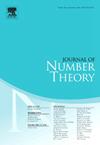Counting numbers that are divisible by the product of their digits
IF 0.6
3区 数学
Q3 MATHEMATICS
引用次数: 0
Abstract
Let be a positive integer. A natural number is said to be a base-b Zuckerman number if it is divisible by the product of its base-b digits (which consequently must be all nonzero). Let be the set of base-b Zuckerman numbers that do not exceed x, and assume that .
First, we prove an upper bound of the form , where is an effectively computable constant. In particular, we have that , which improves upon the previous upper bound due to Sanna. Moreover, we prove that , which improves upon the previous lower bound , due to De Koninck and Luca.
Second, we provide a heuristic suggesting that , where is an effectively computable constant. In particular, we have that .
Third, we provide algorithms to count, respectively enumerate, the elements of , and we determine their complexities. Implementing one of such counting algorithms, we computed for and large values of x (depending on b), and we show that the results are consistent with our heuristic.
计数能被数字的乘积整除的数
设b≥3为正整数。如果一个自然数能被其以b为基数的数字的乘积整除(因此必须全部非零),则称其为以b为基数的祖克曼数。设Zb(x)为不超过x的以b为基底的Zuckerman数的集合,并假设x→+∞。首先,我们证明了形式|Zb(x)|<xzb++o(1)的上界,其中Zb +∈(0,1)是有效可计算常数。特别是,我们有z10+=0.665…,它改进了之前由于Sanna的上限| z10 (x)|<x0.717。此外,我们证明了|Z10(x)|>x0.204,改进了之前的下限|Z10(x)|>x0.122,由于De Koninck和Luca。其次,我们提供了一个启发式建议,即|Zb(x)|=xzb+o(1),其中Zb∈(0,1)是一个有效可计算的常数。特别是z10=0.419....第三,我们提供算法来计数,分别枚举Zb(x)的元素,并确定它们的复杂度。实现这样的计数算法之一,我们计算了|Zb(x)|,对于b=3,…,12和较大的x值(取决于b),我们表明结果与我们的启发式一致。
本文章由计算机程序翻译,如有差异,请以英文原文为准。
求助全文
约1分钟内获得全文
求助全文
来源期刊

Journal of Number Theory
数学-数学
CiteScore
1.30
自引率
14.30%
发文量
122
审稿时长
16 weeks
期刊介绍:
The Journal of Number Theory (JNT) features selected research articles that represent the broad spectrum of interest in contemporary number theory and allied areas. A valuable resource for mathematicians, the journal provides an international forum for the publication of original research in this field.
The Journal of Number Theory is encouraging submissions of quality, long articles where most or all of the technical details are included. The journal now considers and welcomes also papers in Computational Number Theory.
Starting in May 2019, JNT will have a new format with 3 sections:
JNT Prime targets (possibly very long with complete proofs) high impact papers. Articles published in this section will be granted 1 year promotional open access.
JNT General Section is for shorter papers. We particularly encourage submission from junior researchers. Every attempt will be made to expedite the review process for such submissions.
Computational JNT . This section aims to provide a forum to disseminate contributions which make significant use of computer calculations to derive novel number theoretic results. There will be an online repository where supplementary codes and data can be stored.
 求助内容:
求助内容: 应助结果提醒方式:
应助结果提醒方式:


